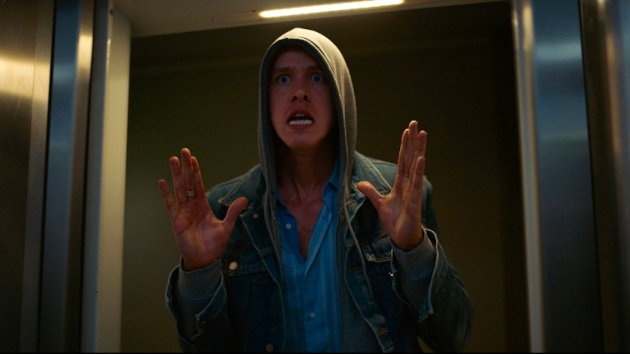Ruben Östlund, writer/director of the masterful Force Majeure (2014), is back to once again question and deconstruct commonly held social beliefs. Instead of looking at the institution of marriage and the roles of husbands and wives, Östlund casts a wider net in Triangle of Sadness (2022). Winner of the Palme d’Or at this year’s Cannes Film Festival, this satirical comedy takes a harsh look at the dynamics of class, wealth, race, beauty, and economic inequalities. Östlund takes a big swing here – going for an absurdist, over the top style. There is nothing subtle about what he is doing. He lays the skewer down on the shallow and vapid nature of extreme wealth. Some might argue that he is reaching for low hanging fruit, others might say the top percenters deserve getting knocked down a peg or two.
Whatever category one might fall, there is no denying that the narrative keeps us on our toes throughout its two-and-a-half-hour runtime. It’s a juggling act of tones. At any given moment, we sense that something terrible might happen. Other times, we get a sequence of obscenity that will either have us laughing or dry heaving. That seems to be what Östlund is going for. He wants to draw out a strong reaction, whether positive or negative. The attempt doesn’t quite come together by the end, but there is such conviction in every frame that it keeps us glued in. Everyone involved commits to their assignments, no matter how gross things become.

The plot is divided into three chapters. The first section introduces us to Carl (Harris Dickinson) and Yaya (the late Charlbi Dean), lovers who both work as models. Just as he did in Force Majeure, Östlund’s writing and direction highlights the complexities of Carl and Yaya’s connection – not just in what is being said, but what is not being said. A conversation over who should pay for dinner slowly builds to a larger argument over what the two expect from one another. For people who have good looks and money, Carl and Yaya feel like they are on the verge of a toxic relationship.
The second act involves Carl and Yaya going on a luxury cruise for the super-rich. It’s here where we meet many colorful characters, including a Russian businessman (Zlatko Buric), a lonely bachelor (Henrik Dorsin), a barely functional captain (Woody Harrelson), a weapons manufacturer (Oliver Ford Davies), and a crew leader (Vicki Berlin) struggling to keep everything running smoothly. The production design (Josefin Åsberg), cinematography (Fredrik Wenzel) and editing (Östlund, Mikel Cee Karlsson) use the boat to delineate between the upper and lower classes. The main deck – with its fancy rooms, pool, and lounge areas – are populated by rich/white characters. The lower decks – where servants, cleaners, and mechanics reside – is filled with people of color. It’s made plainly obvious how the privileged mistreat others. In a telling scene, a character forces the crew to dress in swimsuits and slide into the ocean for their own amusement – as if they were their own personal playthings.
This set up does not last very long, leading to what is undoubtably the most controversial scene. Taking place on a particularly rough night on the water, Östlund pulls the plug on the hierarchy in one of the most nauseating sequences of the year. Characters who pass themselves off as refined and sophisticated are put through the wringer. They are placed in compromised positions that almost made me feel bad for the actors going through it. I won’t go into the details (if you’ve seen trailers or posters, you know what I’m talking about), but the abundant use of “fluid” is taken to extraordinary lengths. Just when we think the mayhem is over, the narrative takes another giant leap (or should I say “hurl?”) forward. It doesn’t help that the camera frame bobs and weaves with the waves, reflecting what happens to the characters. Anyone sensitive to motion sickness should brace themselves.

What happens in this section hits with such blunt force trauma that everything afterward pales in comparison. The third act – where characters deal with the ramifications of their time on the cruise – loses a ton of momentum despite being the most thematically interesting. With the introduction of Abigail (Dolly De Leon) – a Filipino housekeeper who works on the boat – the entire power structure is rearranged. It’s as though Östlund and his team took everyone’s roles and flipped them upside down. Not only does this cause characters to re-evaluate their own positions, but it also highlights how easily power can corrupt those who have it. Once a person obtains control and influence, it’s very difficult for them to let it go, regardless of their background.
The third section is so disconnected to the rest of the story that it could’ve come from a different movie. In terms of theme, I can see what Östlund is trying to do, but the outlandish events on the boat acts as the narrative highpoint. The film’s climax happens in the middle of the timeline rather than near the end. Once we get passed all the slapstick, the energy deflates. What happens afterward is nowhere near as compelling. Too bad, because it’s here where characters shed their facades and reveal who they really are. Some turn out to be better people, others not so much. De Leon delivers a memorable performance despite coming very late to the party. Abigail’s journey may not take as much screentime as Carl and Yaya, but she leaves a strong resonance. Her motivations are immediate and forceful – she goes from an afterthought to perhaps the most important character. How she treats that sudden change is the heart of the film’s themes.
Triangle of Sadness will divide audiences. This isn’t the kind of production that leaves people indifferent. It does drag tremendously in the latter half, and the ideas don’t shed any new social insight. In its messaging, Östlund is preaching to the choir. Yes, people with fame and fortune have a different view of the world – this isn’t exactly a groundbreaking revelation. However, the boldness of Östlund’s vision fills in many of the shortcomings. To have the confidence to let this story play out is admirable. I’m much more fascinated by a movie that aims high and misses rather than one that settles for average. That is precisely what happens here.



